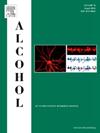Detecting the comorbidity of attention deficit hyperactivity disorder (ADHD) in a population of outpatients with alcohol use disorder (AUD): The role of personality traits, age at first alcohol use and level of craving
IF 2.9
4区 医学
Q3 PHARMACOLOGY & PHARMACY
引用次数: 0
Abstract
Attention-deficit/hyperactivity disorder (ADHD) commonly affects individuals with alcohol use disorder (AUD). However, despite the negative outcomes associated with this comorbidity, ADHD is underdiagnosed in this population. We aim to identify clinical parameters and propose cutoff scores enabling the detection of ADHD among patients with AUD. We retrospectively analyzed data from 199 patients, out of a global sample of 412 who were consecutively admitted to a day hospital for alcohol-related problems between 2009 and 2022. We found that lower level of self-directedness, higher levels of novelty seeking, self-transcendence, harm avoidance and craving, and earlier first alcohol consumption could accurately predict the presence of ADHD in AUD (AUC = 0.926). Self-directedness and novelty seeking had the best predictive abilities: a self-directedness score below 52 was associated with an accuracy of 82% and, combined with a novelty seeking score over 53, the accuracy reached 85%. Such findings could be useful to help clinicians detect ADHD in patients with AUD so that they can receive the adequate care.
检测酒精使用障碍(AUD)门诊患者中注意力缺陷多动障碍(ADHD)的合并症:人格特征、首次饮酒年龄和渴求程度的作用。
注意力缺陷/多动障碍(ADHD)通常会影响酒精使用障碍(AUD)患者。然而,尽管这种并发症会导致不良后果,但在这一人群中,ADHD 的诊断率却很低。我们旨在确定临床参数,并提出能够在 AUD 患者中发现多动症的临界值。我们回顾性分析了 2009 年至 2022 年间因酒精相关问题连续入住日间医院的 412 名全球样本中的 199 名患者的数据。我们发现,较低的自我导向性、较高的寻求新奇、自我超越、避免伤害和渴求水平以及较早的首次饮酒可准确预测AUD患者是否患有多动症(AUC=0.926)。自我导向性和寻求新奇感的预测能力最强:自我导向性得分低于52分的准确率为82%,加上寻求新奇感得分超过53分,准确率达到85%。这些发现可以帮助临床医生发现AUD患者的多动症,从而为他们提供适当的治疗。
本文章由计算机程序翻译,如有差异,请以英文原文为准。
求助全文
约1分钟内获得全文
求助全文
来源期刊

Alcohol
医学-毒理学
CiteScore
4.60
自引率
4.30%
发文量
74
审稿时长
15.6 weeks
期刊介绍:
Alcohol is an international, peer-reviewed journal that is devoted to publishing multi-disciplinary biomedical research on all aspects of the actions or effects of alcohol on the nervous system or on other organ systems. Emphasis is given to studies into the causes and consequences of alcohol abuse and alcoholism, and biomedical aspects of diagnosis, etiology, treatment or prevention of alcohol-related health effects.
Intended for both research scientists and practicing clinicians, the journal publishes original research on the neurobiological, neurobehavioral, and pathophysiological processes associated with alcohol drinking, alcohol abuse, alcohol-seeking behavior, tolerance, dependence, withdrawal, protracted abstinence, and relapse. In addition, the journal reports studies on the effects alcohol on brain mechanisms of neuroplasticity over the life span, biological factors associated with adolescent alcohol abuse, pharmacotherapeutic strategies in the treatment of alcoholism, biological and biochemical markers of alcohol abuse and alcoholism, pathological effects of uncontrolled drinking, biomedical and molecular factors in the effects on liver, immune system, and other organ systems, and biomedical aspects of fetal alcohol spectrum disorder including mechanisms of damage, diagnosis and early detection, treatment, and prevention. Articles are published from all levels of biomedical inquiry, including the following: molecular and cellular studies of alcohol''s actions in vitro and in vivo; animal model studies of genetic, pharmacological, behavioral, developmental or pathophysiological aspects of alcohol; human studies of genetic, behavioral, cognitive, neuroimaging, or pathological aspects of alcohol drinking; clinical studies of diagnosis (including dual diagnosis), treatment, prevention, and epidemiology. The journal will publish 9 issues per year; the accepted abbreviation for Alcohol for bibliographic citation is Alcohol.
 求助内容:
求助内容: 应助结果提醒方式:
应助结果提醒方式:


